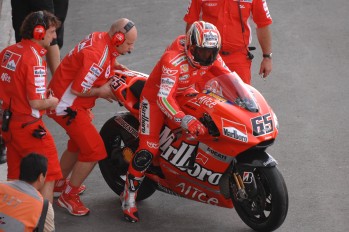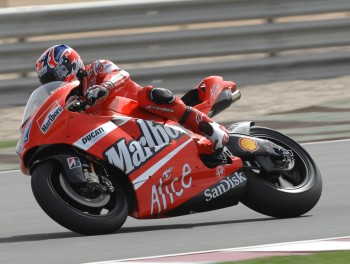|
The first race of the 2007
MotoGP season got off to a surprising start, at least surprising for all
Ducati’s competitors. As has been well documented since the Qatar race, the
Shell-powered Ducati’s top speed was well above all of its competitors. The
question that is being asked is… how is this possible?
Valentino Rossi, when asked
after the race about the Ducati performance, admitted that he, and the Yamaha
engineers, had expected the Desmosedici to run out of fuel before the end of the
race. While speculation was rife on live TV coverage around the globe that the
strong Ducati performance must have been to the detriment of the fuel
consumption, clearly, at the end of the race, this was not the case. There are several reasons
for the Ducati to come out fighting so strong. Not insignificantly this is down
to a talented bunch of engineers in the Borgo Panigale factory. Obviously the
engine design and its components are strong, while the time spent on
aerodynamics appears to have paid off – the Alan Jenkins refined form looking
significantly different from the other bikes on the grid.
‘To finish first, first you
must finish’, says the old adage, which tells us that reliability is essential
if you are to win a race. Shell’s philosophy is to first ensure that Ducati
finishes every race, before the chemists’ attention then turns to producing
extra power without sacrificing the integral reliability. This is done by the
reduction of friction through intelligent lubricant design.
When talking about
motorcycle engine lubricant (not forgetting it also lubricates the bikes’
gearbox), the Ducati Desmosedici GP7 is protected by the latest development of
Shell motorcycle lubricant – Shell Advance L6442. Michael Knaak, Shell
motorcycle lubricant expert, takes up the story: “L6442 was introduced to Ducati
at Donington, 2004, and saw an improvement over the original Shell oil M1854 of
1.2% horsepower. Of course, when we talk about a gain with lubricant, what is
happening is a reduction in friction – this can be translated to better fuel
economy with the same power, or said another way, more power with the same fuel
efficiency.”
Looking at the fuel, new
Shell V-Power PR2772 was first used in anger at the Qatar race where Casey
Stoner very visibly displayed the performance benefits each time he exited the
last turn and stormed away from Valentino Rossi’s Yamaha. How can the fuel make
such a difference, I hear you ask. Joerg Landschof, Shell’s motorcycle fuel
expert, has the answer: “to be honest you have to remember that Ducati have done
a great job with this engine, the desmodronic system is proving very effective
in this smaller capacity engine without the big-bang approach, and our new
V-Power fuel is designed to operate better at high piston speeds with the
smaller swept volume.” Landschof goes on to say:
‘for the 2007 Ducati fuel, Shell V-Power PR2772, our brief was to ensure maximum
horsepower, along with significantly increased fuel efficiency – in the end we
met both targets easily. Even if, after two years of searching for ultimate
power, we had to look in a different direction!”
Where Shell can make the
difference is with the close relationship they have with the Bologna team.
Based in Hamburg, Germany, the Shell scientists have been involved since the
birth of the 990cc desmodronic engine and through the development of the
‘screaming’ 800cc engine for 2007. Critical input that Ducati looks to Shell to
provide can be simple things like oil pressure and temperature parameters – all
essential information when thinking of reliability and performance at the
beginning of the game. For Shell’s part, the continual research and development
that takes place into lubricant and fuels technology can, and has, provided
significant improvements in engine performance without sacrificing reliability –
which can be applied in equal measure to the road.
|
 |
|
Loris Capirossi had an unlucky start to his 2007
MotoGP campaign in Qatar, sliding off the track without injury at one-third distance
while charging forward and aiming for a podium result. |
|
|
 |
|
Casey Stoner
made a perfect start with the Ducati Marlboro Team at Qatar
a week and a half ago, riding to a magnificent season-opening victory aboard
his Desmosedici GP7. |
|
|
Knaak takes up the lubricant
story: “The first oil supplied to Ducati, Shell Advance M1854, was developed to
ensure reliability. In fact, Filippo Preziosi, Ducati Corse technical director,
told me ‘I would sacrifice 5bhp if you can guarantee me reliability!’ M1854
actually produced the same power and gave the reliability required.” This was
courtesy of what Knaak will only call “a very special component” that had taken
“quite a while to discover”. From here on in this special component easily
found more power!’ The MotoGP project benefited greatly from Knaak expertise
all through the 990cc MotoGP era, with subsequent evolutions of the lubricant,
L4181, L6441, and L6442, all giving boosts in performance to the fast improving
Italian machine.
Shell Advance L6442 was used
throughout the development of the 800cc bike, and at the present time Ducati is
testing two new ‘candidates’ that could be replacements – “but only if they
better the friction reduction properties and reliability of L6442”. Lubricant
rules are quite relaxed, and this gives Knaak’s mind the opportunity to
continuously explore the boundaries and ensure that the “shelf of tricks is
always empty”.
Knaak can make improvements
in two basic areas; the base oil, which essentially means finding a better
stream of raw product – this accounts for 75% of the final oil product. But the
remaining 25% is the ‘additive package’ – getting more substantial information
on this topic from Knaak is like extracting blood from a stone. But with a
small smile on his face, he will go as far as to say that for the time being
“the gains will probably come mainly from the additive package”.
Fuel is a very different
prospect. The regulations are much tighter, so the work Shell can do is much
more restricted. But this doesn’t stop Landschof and his team pushing the
boundaries: “during the 990cc era, there were two Shell V-Power products, DF0100
and RD0502, brought to the team – each had the brief of pushing the power up and
succeeded by a total of 1.2%. Although RD0502 also successfully reduced the
specific fuel consumption by around 5%.”Landschof continues “With
regulations coming more into line with Formula One we have less and less to play
with, in fact the components are 99% the same as the pump V-Power fuel you buy
at any Shell service station. However within that 1% we can do quite a lot.
Significantly we are using a new base fuel mix (there are 100s of components in
the base fuel), this combined with a subtle remix of the Shell V-Power additive
package, which includes anti-oxidants, friction modifiers and detergents,
actually found a significant growth in fuel efficiency with maybe a sacrifice of
1bhp. And rest assured we are working to get that 1bhp back with interest and
to find more!”
Again with a wry smile,
Knaak suggests that there is more development to come before the end of the
season…So, final answer to the
question “What made the Shell-powered Ducati so fast in Qatar?” The Ducati
Desmosedici was fast because a small team of dedicated individuals worked closer
than ever to ensure that each area of the bike was optimised to the very limit
of today – from engine performance through aerodynamics to fuels and
lubricants. But it doesn’t end there… what is brilliant today can be simply
ordinary tomorrow, and obsolete the week after. The search for performance will
continue as long as teams like Ducati and Shell race.
|
|
|
|